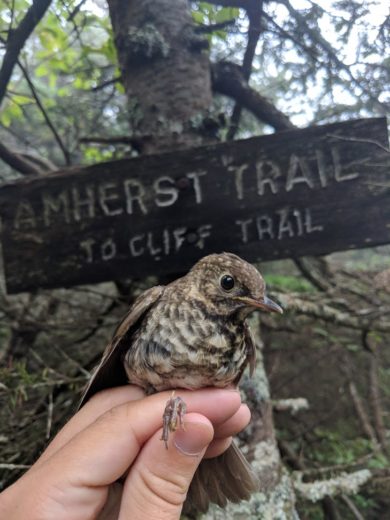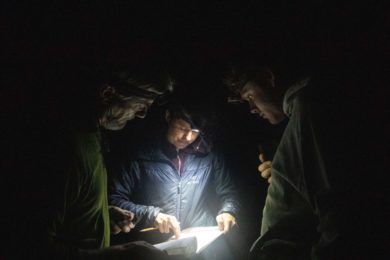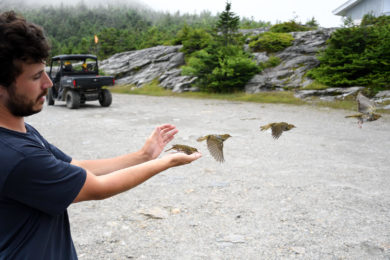
A juvenile Bicknell’s Thrush mist netted on Mansfield’s Amherst Trail. © Nathaniel Sharp
I assumed we were still on Mount Mansfield last Wednesday morning, but there was no visible evidence. I had gone to sleep on the mountaintop late Tuesday night after cleaning up our banding station but awoke in a cloud of fog so thick that it looked like I had landed on another planet. Peering outside my tent, the only visible features were flecks of sparkling mist that eventually formed a thick white wall around us, beneath us, above us—everywhere. It was hard to believe that we had been squinting through sunbeams to untangle birds from our mist nets just yesterday.
I arrived on the mountain Tuesday evening ecstatic. This was my first time on Mansfield and only my third-ever visit to Vermont. A little embarrassing at this point since I’ve worked as VCE’s communications assistant for two months now. The trails were a slurry of mud and wet rock, but the field crew bounded through them like mountain goats, clinging to the tiniest dry footholds, hands full of bird bags. We worked quickly, sometimes too quickly for me to keep track. Perhaps it was because I hadn’t done fieldwork for several years or because I was learning on the fly (pardon the pun).
As the sun dipped into the western haze beyond the Adirondacks, our nets started to fill with birds, though it was a slow night, all things considered. A strong breeze likely made birds wary of our billowing nets. There were ten of us VCEers on the ridgeline, and the mountaintop buzzed with conversation and movement. Pliers cinched bands above little bird feet. Rulers measured wings and tails. Bird rumps peaked out of a cone, like a feathered scoop of ice cream, as they were weighed on a scale. There was so much activity that I was sure we were having a great night—only to find out that we only captured 13 birds before finally closing nets at dusk. Good thing my day job doesn’t involve a lot of math…
As we donned our sleeping bags and set up our tents, the sky of stars was replaced with a dark fog that rolled across the mountaintop. Moisture descended and settled onto our tent flaps, sleeping bags, and the tips of our eyelashes, transforming the landscape overnight.

We awoke in darkness to open nets before the morning chorus. I like to think I understand birds pretty well, but certain aspects of their ecology are still a mystery to me. Like why they wake up at 4:30 am, without a drop of coffee, to scream into a foggy void. The cloud shrouding us seemed to help. Besides keeping us cooler (the expected temperature at lower elevations was 90 degrees F), the fog also likely hid our nets, allowing us to capture 58 unsuspecting birds that morning.
We caught our first Bicknell’s Thrush (BITH) fledglings of the season, along with a diverse suite of other fledgling species. We bagged four male BITH this time; however, only one was eligible for our study. It left with a consolation prize—one of our GPS backpacks—and we hope to see it again on the mountain next June or July. Unfortunately, no birds provided new backpack data this week, I’m afraid, but every capture yields valuable information. Each bird can tell us more about breeding and migration windows, age and sex ratios, molt timing and progression, weight changes, and more. We left the mountain in early afternoon with a total of 71 captures representing 16 different species—not too shabby at all.

Nathaniel Sharp releasing a banded Ovenbird. © Mike Sargent
Our final tally included:
Sharp-shinned Hawk – 1 female
Yellow-bellied Flycatcher – 1 adult
Least Flycatcher – 1 adult
Eastern Phoebe – 2 free-flying juveniles
Black-capped Chickadee – 1 adult
Golden-crowned Kinglet – 2 free-flying juveniles
Red-breasted Nuthatch – 9 free-flying juveniles
Winter Wren – 2 free-flying juveniles
Bicknell’s Thrush – 10 (5 free-flying juveniles, 4 adult M, 1 adult F)
Swainson’s Thrush – 1 adult F
American Robin – 2 (1 free-flying juvenile, 1 adult M)
Dark-eyed Junco (Slate-colored) – 20 (13 free-flying juveniles, 5 adult M, 1 adult F, 1 adult sex unk)
Ovenbird – 1 adult
Blackpoll Warbler – 3 (2 free-flying juvenile, 1 adult M)
Black-throated Blue Warbler – 1 adult F
Yellow-rumped Warbler (Myrtle) – 14 (8 free-flying juveniles, 4 adult F, 1 adult M, 1 adult sex unk)
